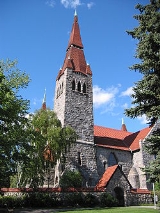
Tampere Cathedral
Encyclopedia
The Tampere Cathedral is a church in Tampere
, Finland
, and the seat of the Diocese of Tampere
. The building was designed in the National Romantic style
by Lars Sonck
, and built between 1902 and 1907.
The cathedral is famous for its fresco
es, painted by the symbolist
Hugo Simberg
between 1905 and 1906. The paintings aroused considerable adverse criticism in their time, featuring versions of Simberg's The Wounded Angel
and The Garden of Death
. Of particular controversy was Simberg's painting of a winged serpent on a red background in the highest point of the ceiling, which some contemporaries interpreted as a symbol of sin and corruption.
The altar-piece, representing the future resurrection of people of all races, was painted by Magnus Enckell
.
Tampere
Tampere is a city in southern Finland. It is the most populous inland city in any of the Nordic countries. The city has a population of , growing to approximately 300,000 people in the conurbation and over 340,000 in the metropolitan area. Tampere is the third most-populous municipality in...
, Finland
Finland
Finland , officially the Republic of Finland, is a Nordic country situated in the Fennoscandian region of Northern Europe. It is bordered by Sweden in the west, Norway in the north and Russia in the east, while Estonia lies to its south across the Gulf of Finland.Around 5.4 million people reside...
, and the seat of the Diocese of Tampere
Diocese of Tampere
The Diocese of Tampere is the second oldest and the largest diocese in the Evangelical Lutheran Church of Finland. It is divided into 69 parishes with a total population of over 660,000 people. The diocese is led by the Bishop of Tampere.-History:...
. The building was designed in the National Romantic style
National Romantic Style
The National Romantic style was a Nordic architectural style that was part of the national romantic movement during the late 19th and early 20th century. Designers turned to early Medieval and even prehistoric precedents to construct a style appropriate to the perceived character of a people...
by Lars Sonck
Lars Sonck
Lars Eliel Sonck was a Finnish architect. He graduated from Helsinki Polytechnic Institute in 1894 and immediately won a major design competition for a church in Turku, ahead of many established architects.Sonck ignored the growing trend toward architectural rationalism...
, and built between 1902 and 1907.
The cathedral is famous for its fresco
Fresco
Fresco is any of several related mural painting types, executed on plaster on walls or ceilings. The word fresco comes from the Greek word affresca which derives from the Latin word for "fresh". Frescoes first developed in the ancient world and continued to be popular through the Renaissance...
es, painted by the symbolist
Symbolism (arts)
Symbolism was a late nineteenth-century art movement of French, Russian and Belgian origin in poetry and other arts. In literature, the style had its beginnings with the publication Les Fleurs du mal by Charles Baudelaire...
Hugo Simberg
Hugo Simberg
Hugo Gerhard Simberg was a Finnish symbolist painter and graphic artist.-Life:Simberg was born at Hamina in Finland, the son of Colonel Nicolai Simberg and Ebba Matilda Simberg ....
between 1905 and 1906. The paintings aroused considerable adverse criticism in their time, featuring versions of Simberg's The Wounded Angel
The Wounded Angel
The Wounded Angel is a painting by Finnish symbolist painter Hugo Simberg. It is one of the most recognizable of Simberg's works, and was voted Finland's "national painting" in a vote held by the Ateneum art museum in 2006....
and The Garden of Death
The Garden of Death
The Garden of Death is a painting by Finnish symbolist painter Hugo Simberg. Like many of Simberg's paintings, it depicts a gloomy, otherworldly scene...
. Of particular controversy was Simberg's painting of a winged serpent on a red background in the highest point of the ceiling, which some contemporaries interpreted as a symbol of sin and corruption.
The altar-piece, representing the future resurrection of people of all races, was painted by Magnus Enckell
Magnus Enckell
Magnus Knut Enckell was a Finnish painter.Enckell was born in Hamina, a small town in eastern Finland, the son of Carl Enkell, a priest, and Alexandra Enckell...
.

